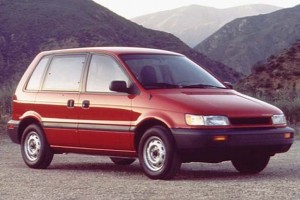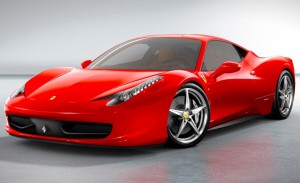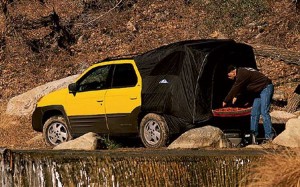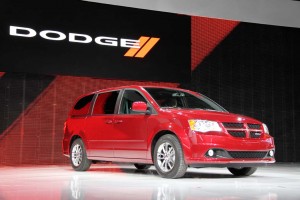
Beauty is clearly in the eye of the beholder. But what does our columnist find so appealing in the Colt Vista?
“I think this is the nicest car you ever had,” my mother said to me from the passenger’s seat. Her eyes, still a snapping dark brown in her late 80s, choked off my emergent laugh though that’s the response the remark deserved.
After all we were not in my Porsche, my Alfa, my Lancia, my Ferrari – cars I had owned serially over a few decades. We were not even in the MG-TC in which she had shared an at-limit dart up Mt. Diablo — clinging tightly and smiling broadly though precariously exposed to traffic in this right-hand drive roller skate. Nor were we in the semi-rally-prepped Mini Cooper in which we toured a newly opened-to-foreign-traffic USSR in the mid-1960s.
No. The car she had proclaimed to be my “nicest” ever was a white Colt Vista. Colt Vista! A minivan-tall-station-wagon sort of vehicle that was badged a Dodge and imported in limited numbers when Mitsubishi and Chrysler had some sort of patty-cake relationship.
Instead of laughing I set to musing about what is it that earns a car the “nicest” title. I realized that the Colt Vista restored to my mother some fading independence. She did not need my help to get down into it or up out of it like she did in my sportier machines. (SUVS, with their demand for a Sherpa gene to ascend, had not yet invaded the marketplace.) The Vista door opened wide and stayed there yet at least a part of it could be reached while seated to pull it to. The car seat matched her seat height. She could simply turn, plonk down then swing her legs over the low sill. Voila! In.

Okay, it's easy to fall in love with the Ferrari 458, but is it the "nicest" car our author has driven?
The Vista’s high roof line combined with the low step-over height eliminated that awkward task of simultaneously ducking the head and lifting the legs, a jackknifing that age makes ever more problematic, especially on those days when “Arthur”, as Mother called her painful stiffening, was visiting.
Once in place Mother could even reach the seat belt and snap it by herself. Because the car had no extreme rake to the windshield with the accompanying vast acreage stretching ahead and because the side windows were wide and high she could be a part of the outside world as well, perhaps a minor but nonetheless empowering ability as age shrunk her sitting height.
Mother had noticed in our drives how the folding rear seats and the wide-opening rear doors made loading and unloading stuff easy. The wide yawning hatch ditto. We carried some awkward and variously-shaped stuff home from flea marketing, too. And flats loaded with leafy plants slid in and out easily. It was this utility, flexibility and versatility that endeared me to the Vista.
The “nicest” car? Well, certainly it nicely assisted me and Mom in our assorted tasks. That’s nice. But I’m reluctant to attach a blanket “est” to anything. Except maybe “fastest” because that has a number and numbers tend to be rigid, ultimate and “-est”-ish. And maybe the least interesting to me for that reason. I like blurring the trees as much as anyone and feeling Gs pin me to the seat, but so many really fast cars don’t feel as fast as something more nimble, lighter, responsive. And it’s the feeling that counts.
Maybe if I hadn’t once owned the style, excitement, power and sound of my Porsche, Alfa and Ferrari or if in my job hadn’t allowed me access to many of the latest hot wheels as they wound their way to public introduction I would not have been so content with the simple niceness of a Colt Vista. I did get the “never thought I’d see you driving one of those,” remarks, which always puzzled me. And annoyed me, too. I’d make a stroppy retort like: “I define the cars I drive, I don’t let them define me.” Whatever that meant.
I see to it that I enjoy every vehicle I drive though some do, indeed, make it easier than others. Just as I seldom give up entirely on a movie enough to walk out I rarely completely dismiss a car I drive. I trust there is some reason it exists, even if it is to scrape a few more dollars from a model long past its use-by date. Or take the Aztec (please). That lumpish creation, a misguided attempt to design for a misinterpreted “youth” market, had within it an inventive interior with innovative tucking places and general usefulness. (And anyway when a vehicle looks like the Aztec it is better to own one than not. Being inside your Aztec means that is one less you are apt to see out your windshield and thus ruin your whole day.)
When I get into a new car I empty myself of expectations. I try to determine for whom the car was intended. What purpose was in the designer’s mind? What was it supposed to do? How honest and directed was that intention? And how well does the car fulfill those goals? In that mode I can with reason describe to you the car’s successes and failures and how it will serve your needs or fall short. That’s the mode in which I might agree with Mom that the Colt Vista was the “nicest” car I ever had.
Then there is that other mode that is a sort of overdrive to reason. It’s activated by a switch that simply turns you on. You ask no sensible questions, furrow no brow, ponder no motives. Further you find no fault or even virtue – you simply open the connection to the pleasure centers, like a lab animal, and enjoy with silly grin. You are delighted, amused, transported, entranced.
Only later in retrospect do you acknowledge the subjectivity of the experience and write of it accordingly allowing for the difference between “fond of” and “love.” Such an important difference that switch is because it comes with a ton of forgiveness. In that transcendent mode you become instantly forgiving of what reason would perceive as shortcomings. Flaws become endearing even. (Isn’t that droll — you can burn your leg on the exhaust.)
Aside: I have a theory. Toyota in its intense history has been able to engender admiration, respect, even a certain fondness, but not the passion of love for its vehicles. Suddenly when what it was admired for – reliability – came under question with “unintended acceleration” there was no safety net to catch the company’s reputation. No blindfold of love to ignore the reports. Toyota fell precipitously, though really unaccountably.
Official reassurance, arriving later, has helped and buyers, still skittish, are coming back to the showrooms of a stunned Toyota. It was not that Toyota hasn’t tried to be loved but it seems as soon as they create a likely candidate they change it. (“Mister Two,” for example. I’d say lovable.) Forcing love is hopeless. Piling up amenities doesn’t do it. It’s the entirety of the experience that matters. The pearls have to have a string. Until Toyota discovers the magic flint that sparks love they risk another plunge when “recall” echoes through the garage. End aside.
So my intent when I started this McBlog was to write about the virtues of the minivan and my puzzlement over why this sense-making configuration has inspired so many “anything but” sentiments. And this among the very people who would best benefit from a minivan. You see how far I wondered. But think again of my “nicest car”. Its virtues are the minivan virtues – versatile, efficient use of space. The best on wheels. The SUV, which displaced the minivan and to some degree the wagon in the affections of the American buying public, is largely an image machine. Yes, an SUV, or some at least, can conquer the Rubicon, wade deep in gumbo mud and leap tall buildings, but rarely are they called upon to do more than crunch the gravel on a golf club parking lot. And most SUVs promise more than they can deliver. It’s that look that gets the buyers.
I understand the appeal of that look. An SUV is a Burberry trench coat with epaulets and a belt you tie despite its buckle. It turns rain to beads that roll off but it’s just as popular on a cloudless day. Or was. You don’t see many sun-time trench coats now that Columbo’s gone. But the SUV look holds its popularity despite how difficult it is for little ones or old ones to get in or out. Reason says it takes more space than it offers for use and its weight and billboard shape make for poor CAFÉ numbers. Reason yields to the image. Many SUVs have been tamed to a unibody and dubbed a crossover which plays hob with towing ability. And still they trail the minivan in efficiency. (But, yes, they are appealing.)
Efforts to give the minivan more curb appeal for SUV fans are fruitless. And maybe eventually unnecessary. Maybe as economy and efficiency return (yet again) as a higher-valued virtue minivans will look better just as some bar habitués blossom with the downing of beers and passage of time.
And maybe some other virtues will emerge. I heard from a man who was caught without his usual high performance ride when a lease expired so he borrowed his wife’s minivan. And kept it. A change of tires and a little attention found it handling downright impressively. He liked the ease of access to varied storage configurations and he claims it saved him a ton of money. No, not on gas, though there was much less spent per pump visit, but on tickets. Though he insists he drives his “Meni”(sic) van with the same elan he did his high performance cars he is ignored by cops as if swathed in a Harry Potter cloak. He has dark-filmed the windows and canceled his hot car order. He is now proselytizing on behalf of “Menivans.”
One happy convert does not a trend make, but wait. At a press intro of the Toyota Sienna I met the young engineer responsible for it. He was a week-end racer and that enthusiasm he had transferred to the Sienna. Yes, it is as Soccer Momish as you wish but push it hard and it grabs at the road and says “OK. Let’s dance.” Fun in a minivan? It happened. Particularly at the base level.
At a Dodge event I had to smile at the new Caravan. They’ve divided up chores at the Chrysler house and Dodge drew “performance”. The Dodge boys took the assignment seriously. It was easy enough with cars called Challenger and Charger. But they got the Caravan right, too. The Caravan just sitting there accepts its past and dismisses it at the same time. Taut and lower, body-colored where bright work once was, it barely registers on the retina yet leaves an impression: one of quiet confidence and the pared style of shunning stylishness. “Man van” the sign behind it says. Ah, the calm chill of stealth. Imagine, a cool minivan.
I have previously in this space made known my delight in the Ford Transit Connect. I also like the Ford Flex and the Chevy HHR. And the Mini Countryman and Suzuki SX4. Suspect a pattern? And oh yes, the Kia Soul, the Mazda2, the Fiat 500. What pattern? But if I had to choose blindfolded and ear-muffed I would hope I were in Germany. I’d feel around for a tight-bodied sport wagon. Diesel of course. Now that is really nice. I’d hope Mom might have agreed.



I’d like to put in a positive word for my old 2000 Audi A4 Avant Quattro 1.8T/5-spd. Overall, that was the finest vehicle I’ve ever owned. Darn thing got 45mpg when I drove it 55mph…although I could only do that at length in the UP and out west.
I have been saving my first-year Windstar for a full engine/trans rebuild, though. That one was great, if not for Ford’s issues with the aluminum head seal and that damn transmission. If I could find a wrecked SHO, I’d swap out for a manual transmission…and you’d see me on Woodward during the next Dream Cruise!
I’ve a penchant for being first in with some serious machines. Bought the first GTI sold off Melton Motor’s lot in late 1982, had two of those gems in my lifetime.
Also bought one of the first Contour SVTs sold down in Taylor…although THAT car brought out the idiot bully buried deep within my psyche.
All told, I agree with you. The MINIVAN that everyone scorned was the overall best vehicle ever to grace my garages over the years…but the STATION WAGON from Germany was a ton more fun.
Of the criteria you mentioned, my current vehicle…a Saturn Vue…ranks right up there. IF we’d gotten the manual trans, it might have been a keeper. Well, if GM hadn’t gotten idiotic and killed off their friendly dealer network. (I’m still a little peeved at that one, LOL!)
Cheers, great article.
John
Detroit
John,
As I mentioned to Denise after receiving her story, I frequently am asked what my “favorite car” is. “For what?” I usually respond, or perhaps, “At what price.” It’s easy to say you’d love a 911 Turbo if I intend to use it on some wonderful back country roads I know near Monterey, or outside San Diego. But more often I am hauling friends, or cargo, or taking a long drive and watching my mileage. So, my preferences really are conditional.
Paul A. Eisenstein
Publisher, TheDetroitBureau.com